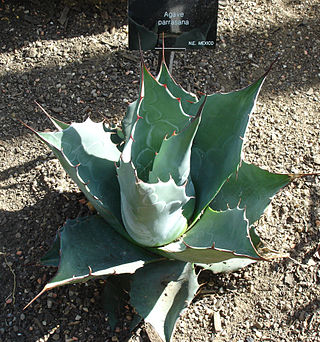Agave parrasana
Species of plant in the family Asparagaceae From Wikipedia, the free encyclopedia
Agave parrasana, the cabbage head agave or cabbage head century plant,[3] is a flowering plant in the family Asparagaceae.[4] A slow-growing evergreen succulent from North East Mexico, it produces a compact rosette of fleshy thorn-tipped grey-green leaves, 60 cm tall and wide. The leaves are blue green and the thorns are red. The whole plant may reach 100 centimeters tall and wide.[5] Occasionally, mature plants produce a spectacular flower head up to 6m tall, opening red and turning yellow.[6] This signals the death of the flowering rosette. However, offsets may form and continue growing.
| Agave parrasana | |
|---|---|
 | |
| Kew Gardens, August 2005 (Bluemoose) | |
| Scientific classification | |
| Kingdom: | Plantae |
| Clade: | Tracheophytes |
| Clade: | Angiosperms |
| Clade: | Monocots |
| Order: | Asparagales |
| Family: | Asparagaceae |
| Subfamily: | Agavoideae |
| Genus: | Agave |
| Species: | A. parrasana |
| Binomial name | |
| Agave parrasana | |
| Synonyms | |
|
Agave wislizeni subsp. parrasana | |
As it can tolerate temperatures of −12 °C (10 °F) or less, it is a popular plant to grow outdoors in a sheltered cactus garden or similar environment, and has gained the Royal Horticultural Society's Award of Garden Merit.[7] In the US, it may be grown outdoors in USDA hardiness zones 7–10. It is susceptible to scale and chlorosis resulting from magnesium deficiency.[8]
References
Wikiwand - on
Seamless Wikipedia browsing. On steroids.

